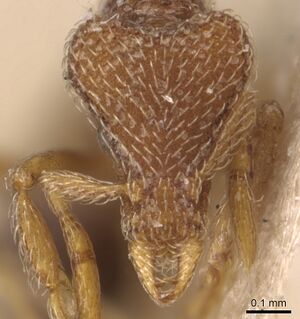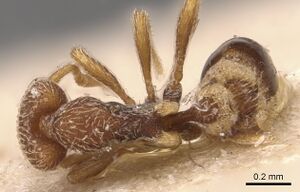Strumigenys biroi
| Strumigenys biroi | |
|---|---|

| |
| Scientific classification | |
| Kingdom: | Animalia |
| Phylum: | Arthropoda |
| Class: | Insecta |
| Order: | Hymenoptera |
| Family: | Formicidae |
| Subfamily: | Myrmicinae |
| Tribe: | Attini |
| Genus: | Strumigenys |
| Species: | S. biroi |
| Binomial name | |
| Strumigenys biroi Emery, 1897 | |
Label data from two collected note the ants were collected in rainforest from a litter sample.
Identification
Bolton (2000) - A member of the Strumigenys biroi-group. There may be two sibling species concealed under this name as some individuals have the propodeal dorsum smooth whilst in others there is punctate sculpture present.
S. biroi is closest related to Strumigenys pulchra, the two are only separated on the details of sculpture noted below. The two together are easily distinguished from Strumigenys basiliska and Strumigenys undras as both of these have an unsculptured promesonotum and lack flagellate hairs at the pronotal humeri and on the basitarsi.
Keys including this Species
Distribution
Latitudinal Distribution Pattern
Latitudinal Range: -3.133° to -8.883330345°.
| North Temperate |
North Subtropical |
Tropical | South Subtropical |
South Temperate |
- Source: AntMaps
Distribution based on Regional Taxon Lists
Indo-Australian Region: Indonesia, New Guinea (type locality).
Distribution based on AntMaps
Distribution based on AntWeb specimens
Check data from AntWeb
Countries Occupied
| Number of countries occupied by this species based on AntWiki Regional Taxon Lists. In general, fewer countries occupied indicates a narrower range, while more countries indicates a more widespread species. |

|
Estimated Abundance
| Relative abundance based on number of AntMaps records per species (this species within the purple bar). Fewer records (to the left) indicates a less abundant/encountered species while more records (to the right) indicates more abundant/encountered species. |

|
Biology
|
Castes
Worker
Images from AntWeb
   
| |
| Syntype of Strumigenys biroi. Worker. Specimen code casent0904949. Photographer Will Ericson, uploaded by California Academy of Sciences. | Owned by MSNG, Genoa, Italy. |
Nomenclature
The following information is derived from Barry Bolton's Online Catalogue of the Ants of the World.
- biroi. Strumigenys biroi Emery, 1897c: 580, pl. 14, fig. 16 (w.) NEW GUINEA. See also: Bolton, 2000: 751.
Unless otherwise noted the text for the remainder of this section is reported from the publication that includes the original description.
Description
Worker
Bolton (2000) - TL 1.9-2.0, HL 0.48-0.52, HW 0.37-0.40, CI 75-81, ML 0.14-0.16, MI 28-32, SL 0.23-0.25, SI 60-65, PW 0.22-0.25, AL 0.53-0.60 (10 measured).
Dorsolateral margin of head with a closely applied row of spatulate hairs, without freely laterally projecting hairs anywhere on margin. Cephalic dorsum with conspicuous narrowly spatulate ground-pilosity that is closely applied to the surface. Pronotal humeral hair flagellate; mesonotum with a single pair of erect flagellate hairs. Ground-pilosity on promesonotum as on head but not as dense. Dorsum of head and promesonotum densely reticulate-punctate. Pleurae and side of propodeum smooth and shining. Propodeum without trace of cuticular teeth, instead the declivity with a thickly spongiform broad lamella that extends its entire depth. In dorsal view the propodeum terminates in a pair of posteriorly directed thick spongiform lobes, the apices of the lamellae. Dorsal (outer) surface of each middle and hind basitarsus with a single long flagellate erect hair. Disc of postpetiole mostly to entirely smooth, at most with a few very short and feeble costulae at extreme anterior margin. Hairs on first gastral tergite extremely sparse; 2-4 inconspicuous fine hairs present at base that are inclined anteriorly toward the limbus. Tergite otherwise without standing hairs although very sparse minute appressed pubescence is present. Basigastral costulae short, their length on the tergite proper no greater than their length on the limbus.
Type Material
Bolton (2000) - Syntype workers, PAPUA NEW GUINEA: Madang (=Friedrich-Wilhelmshafen), and Aitape (= Berlinhafen) (L. Biro) (Hungarian Natural History Museum) [examined].
References
- Bolton, B. 1995b. A new general catalogue of the ants of the world. Cambridge, Mass.: Harvard University Press, 504 pp. (page 396, revived combination, in catalogue)
- Bolton, B. 2000. The ant tribe Dacetini. Memoirs of the American Entomological Institute. 65:1-1028. (page 751, redescription of worker)
- Brown, W. L., Jr. 1948. A preliminary generic revision of the higher Dacetini (Hymenoptera: Formicidae). Transactions of the American Entomological Society. 74: 101-129. (page 103, Combination in Labidogenys)
- Emery, C. 1897c. Formicidarum species novae vel minus cognitae in collectione Musaei Nationalis Hungarici quas in Nova-Guinea, colonia germanica, collegit L. Biró. Természetr. Füz. 20: 571-599 (page 580, pl. 14, fig. 16 worker described)
References based on Global Ant Biodiversity Informatics
- Bolton, B. 2000. The Ant Tribe Dacetini. Memoirs of the American Entomological Institute 65
- CSIRO Collection
- Chapman, J. W., and Capco, S. R. 1951. Check list of the ants (Hymenoptera: Formicidae) of Asia. Monogr. Inst. Sci. Technol. Manila 1: 1-327
- Dahl F. 1901. Das Leben der Ameisen im Bismarck-Archipel, nach eigenen Beobachtungen vergleichend dargestellt. Mitt. Zool. Mus. Berl. 2: 1-70.
- Emery C. 1897. Formicidarum species novae vel minus cognitae in collectione Musaei Nationalis Hungarici quas in Nova-Guinea, colonia germanica, collegit L. Biró. Természetrajzi Füzetek 20: 571-599.
- Field Museum Collection, Chicago, Illinois (C. Moreau)
- Forel A. 1901. Formiciden aus dem Bismarck-Archipel, auf Grundlage des von Prof. Dr. F. Dahl gesammelten Materials. Mitt. Zool. Mus. Berl. 2: 4-37.
- Janda M., G. D. Alpert, M. L. Borowiec, E. P. Economo, P. Klimes, E. Sarnat, and S. O. Shattuck. 2011. Cheklist of ants described and recorded from New Guinea and associated islands. Available on http://www.newguineants.org/. Accessed on 24th Feb. 2011.
- Lucky A., E. Sarnat, and L. Alonso. 2011. Ants of the Muller Range, Papua New Guinea, Chapter 10. In Richards, S. J. and Gamui, B. G. (editors). 2013. Rapid Biological Assessments of the Nakanai Mountains and the upper Strickland Basin: surveying the biodiversity of Papua New Guineas sublime karst environments. RAP Bulletin of Biological Assessment 60. Conservation International. Arlington, VA.
- Viehmeyer H. 1912. Ameisen aus Deutsch Neuguinea gesammelt von Dr. O. Schlaginhaufen. Nebst einem Verzeichnisse der papuanischen Arten. Abhandlungen und Berichte des Königlichen Zoologischen und Anthropologische-Ethnographischen Museums zu Dresden 14: 1-26.
- Wheeler W.M. 1935. Check list of the ants of Oceania. Occasional Papers of the Bernice Pauahi Bishop Museum 11(11):1-56.
- Wheeler, William Morton.1935.Checklist of the Ants of Oceania.Occasional Papers 11(11): 3-56

